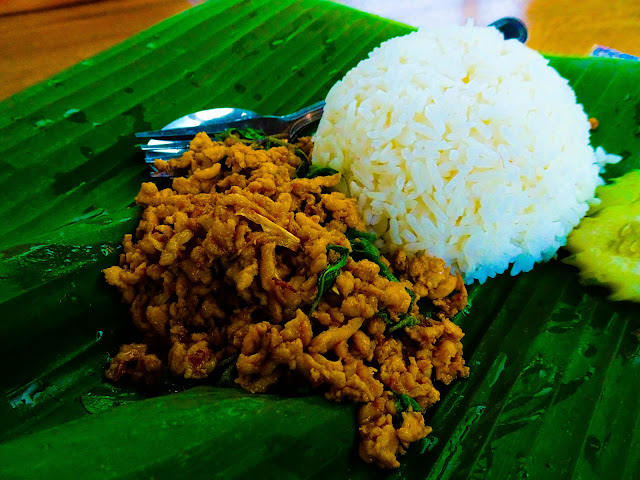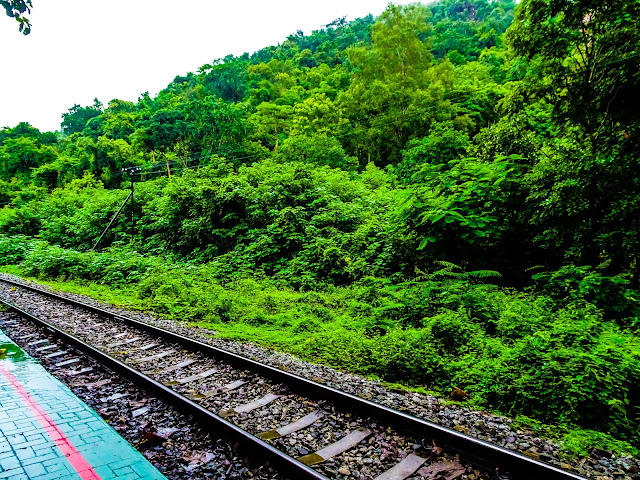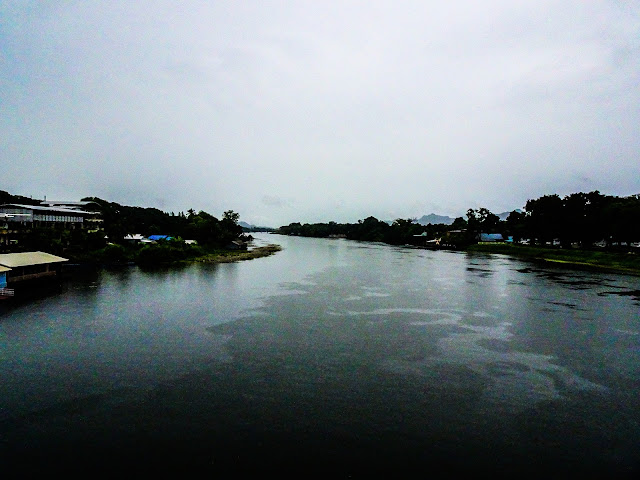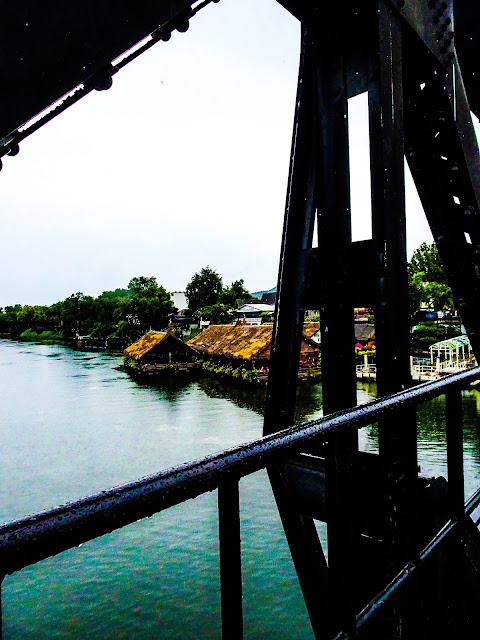There're a lot of pictures for today.
When I say a lot, I really mean a lot.
Kanchanaburi is, after all, an interesting, fascinating town with tourist sights spiritual, cultural and historical, and if coming to Bangkok means I have a lot of pictures, coming to Kanchanaburi- two hours out of the capital- means I have much more.
It was an early start that we had this morning.
Few are the times that I have to leave the hotel this early (except maybe when I do have an early morning flight) but today the driver was coming at 730am, so we had a quick breakfast- hence no pictures- and off we headed to the lobby.
From Bangkok the car took us straight out to Kanchanaburi on what was a two hour long journey.
So quick and efficient was he that we reached there around 930am without making a single stop at all.
First sight of the day was the Tiger Cave Temple, or Wat Tham Seua. Located at Muang Chum in the Tha Muang District, about 4km away beyond Wachiralongkorn Dam, the temple was built in 1973 in a mixed Thai-Chinese style.
One of the most famous temples in Kanchanaburi Province, she is known to have the largest Buddha Image in the province at 18m high, and 10m wide.
Not just that, she is also known for her breathtaking, panoramic views of the Mae Klong River, and the lovely green hue of the province's rice fields.
According to the reviews there is a cable car that takes you right up to the top of the temple, but somehow we must have missed it, because all we saw were the steps, and up we went, climbing our way to the top.
Before that, however, we stopped by the main sanctuary hall- an airy, bright one it was- and visited (what I think is) a limestone cave.
I know nothing about caves, I know nothing what and how they're formed, and I know nothing too of what they symbolize, so I can't describe it in any way at all.
But I was fascinated by the air, the atmosphere, and the fact that I was inside the very hill that I had just looked upon. One section of the cave today serves as a shrine, and a place of blessings, respect and prayer.
Visitors are usually encouraged to make respects here before going to the other parts of the temple, by the way, and whilst it is not demanded of you, it is nice to.
Outside the cave we climbed up the flight of steps built onto the side of the hill, and reached a place where the Buddha Image stood, and from where, rose pagodas of beautiful architecture.
Somewhere along the way I came upon an area where beautifully painted, larger-than-life sculptures had been arranged in a way that made it seem like they were all gazing out earnestly over the water.
To some of us, the sight of these lifelike sculptures might seem a little mysterious, mystical, maybe even frightening, but I found myself remarkably intrigued by them.
There would be a reason why they were there, wouldn't it?
What's more, a good variety of animals had been represented in this very spot, in this very area. One might have thought it would only be tigers, for instance, what with this being a Tiger Cave after all, or perhaps there might be creatures native to the province, but besides the rooster and the cow and the pig and the rabbit, there was a horse and a supremely large parrot right in the center too.
I wish I knew the inspiration behind this part of the temple.
Would it be that there were all these animals living here in the trees and forests and jungles surrounding the temple but we didn't know it?
Would it be that some of them were native, and some of them weren't?
What were they looking at, I wonder, and just why were they all looking out towards the water?
There's much to learn about Wat Tham Seau, its history, its significance, and its purpose.
I'd like to know just what it is that's within the Chinese-style pagoda.
I'd also like to know just what it is that lies behind all these little windows of what I think looks like a sort of stupa.
One, of course, needs no introduction to the towering statue of the Buddha Image decked with mosaic, done with a craftsmanship so skilled that it demands respect.
There weren't many people here on this afternoon save for a couple and a solo traveler lady paying her respects, whom, afterwards, I helped take a picture together with the statue and the roofs rising high behind.
By the way, the view here too was astounding.
At first glance it doesn't look like much, but a longer look reveals all these houses and all these trees right by the water, and the sense of quiet and serenity was quietly calming.
From here we began making our way back to the foot of the hill, but not before stopping by the restroom, which, I have to say, was neat and clean and surprisngly colorful and even though there was no flush system, there was a scoop and more than enough water in the hold beside the bidet that you could manually flush everything down.
An escalator is being built at Wat Tham Seau, by the way, and that, I think, would make it much more convenient for elderly devotees and visitors to come in the future.
From here we headed off for lunch at a nearby place called Meena Cafe.
It's not a very huge sort of place, but it's got a coffee machine, drinks, cakes small bites, and a simple mains menu.
We weren't very hungry so decided we'd just have a plate of basil rice and a cup of cold butterfly soda.
The most significant thing about this cafe was the decor, and the atmosphere. You placed your order at the main counter, then headed down a flight of steps to a sort of little garden hut where you could sit and have your meal.
What I liked about this hut was just how rustic it looked.
When I say rustic, I don't mean it in an ulu kampong sort of way, but a Thai cottage-core style of way where the walls make me think of woven bamboo mats and the windows are sturdy and strong.
I'm not kidding about the feel of cottagecore either, because outside one of her windows is a view that makes one think of a small country lane leading out to a road.
If you appreciate the rustic charm that makes Meena Cafe special, what will make it even more unique is the realization that you're actually right in the middle of a huge rice field, with Wat Tham Seau in the distance backdrop.
That's when you know you're really in Thailand.
Lunch over, we headed over to the Death Railway.
I must first admit that I didn't know what to expect- in fact I didn't even know just where exactly we were going, or where we would be boarding the train, or if we would be boarding the train at all.
As it turned out, the driver took us to Saphan Tam Krasae (or Thamkra Sae) where we were first greeted by a row of touristy shops, then guided into the station proper. Here we could walk along the railway line, and afterwards, take a train to this place Tha Kilen.
Shall we say that I was thoroughly fascinated by what I saw here at Thamkra Sae?
For years- years- I had seen pictures of this Railway in both BW and Colors.
Whether it were in the secondary-level textbook, history guidebooks, travel guidebooks, online resources, or resources about the Japanese Occupation and WWII, I'd seen, more than once, a picture or two.
And here I were seeing it in the real.
Finally.
For someone who had since her teenage years an unexplainable love for history and wartime history, seeing this was a genuine thrill, and cliche as it is, like a dream come true.
I shan't go into detail of how the Death Railway came about.
But it was built between the years of 1940 to 1943, ran for a total of 415km between Thailand and Burma, and was built using forced labor. The route ran through the Three Pagodas Pass, with 111km of the railway in Thailand, and the remaining in Myanmar.
I'm not sure what the name this section of the railway was called- if there was a name.
But I'm trying to imagine just how this could have been built during those times, what sort of engineering did they need, what sort of intensive, back-breaking labor must have been used, what sort of tools they had on them, and how had been the weather.
How would it have been possible to build this bridge over the waters of the river?
How and where did the laborers have a firm footing when laying down the foundations that form these structures?
I've no idea what the engineering terms of these structures are.
Like, what do they call them?
This afternoon the train that we took likely was No. 258, coming down from Nam Tok Station heading towards Kanchanaburi before ending at Thonburi. From Saphan Tam Krasae to Tha Kilen there were two other stations along the way, covering Lumsum first, then Wang Sing.
At Saphan Tam Krasae I snapped a couple of pictures, including what looks like to be the signalers' hut on the opposite side of the line, as well as a sort of cave- which I don't know what it's meant for but I entered anyway. There was also a viaduct, which we walked across, rather gingerly and carefully, I must add.
It cost 100B/pax for foreigners to get to Tha Kilen.
Actually it costs 100B/pax for foreigners to get to anywhere up and down this line, but our scheduled stop was Tha Kilen, so Tha Kilen it was.
It's been a long time since I last sat in a 3rd class carriage of a train.
And in a sort of odd way, I was a little glad to see that not much had changed. The seats were cushioned blue, the pull-up windows were all open, and the fans- mounted on the carriage ceiling- were still there.
After a while we managed to secure seats by the open window and so that got me as close as possible it was to the nature and scenery of Kanchanaburi.
The guide was waiting for us when we alighted at Tha Kilen, so into the car we got and off to this place called Mallika City.
This tourist site is an interesting place.
But it's also one of those places that- to the poor lost tourist- is a little hard to define.
I like to think of it as a working museum.
And yet, at the same time, it's not really that way either.
So the easiest way to describe it is, as per their website, that Mallika City is a retro-city reflecting the past Siamese lifestyle in the Chao Phraya River Basin. The key point that begins this very huge replica, and reflection of this lifestyle, is the abolition of slavery during the reign of King Chulalongkorn circa 1905.
It was then, it is said, that people's lives drastically changed.
Where they were once slaves, they now had to earn a living for themselves without the support and control of their noblemen and their masters anymore. Now they had to learn to be self-reliant, self-sufficient, and live with others around them in their place of work and place of abode.
And so it is here in Mallika City that you get to experience the overwhelming presence of Siamese agriculture, skilled labor, skilled crafts, and trade, as it were, back in 1905 over a century ago.
What makes this place interesting is that, whilst on one hand, walking through it makes you feel like you're walking through a museum, yet, on the other hand, all of the food, the items, the drinks, the snacks, everything- were on sale.
At first we didn't know.
We weren't sure whether the food, the drinks, the snacks, the items etc were part of a very realistic display, or for sale but we soon realized that, had we wanted, we could have bought a bowl of dessert, bought a crepe, tried a mango salad, or a fresh coconut drink. We might also have had a bowl of soup, or stew, or a porridge.
This afternoon we took the casual approach and simply wandered up and about all around the place.
Funny thing about Mallika City is that there weren't many signs- you just had to take it as you came along- but had I seen the website before coming here, I would have known that the place had been divided into several zones.
There was the Ancient Market Zone.
There was the Turnable Bridge, or the Saphan Han.
There was the Reuan Dieow.
There was the Reuan Khaha Bodi.
Then there was the Reuan Pae Floating House, the Cooking House, and the Reuan Hmoo.
I had taken notice of the Reuan Khaha Bodi but because from the outside it seemed empty, I decided not to go in.
I had also taken notice of the Floating House by the water (I think that's where they offer soups, stews and desserts for sale).
Then again, it might have been the Cooking Kitchen.
I wouldn't know.
I did spend a good deal of time wandering about the Ancient Market Zone though.
I don't know if the names of these zones- the Prange Nara Road Zone, the Prange Phutorn Road Zone, and the Prange Sapparsat Road zone are still here in present-day Bangkok today, but Bangrak and Yaowarat are most certainly still there.
I guess that's the fascinating part about history, preservation and re-creation.
You won't know what's been transformed.
Neither will you know what still remains firmly there.
The level of detail here was exquisite though.
So much so that it could well have been a movie set on its own.
It wasn't all just buildings and structures and open stalls.
We came upon a duck farm, which delighted me as I'd heard so much about duck farms but had never seen one this close before.
All in all I think we went around the place a couple of rounds, and whilst I'm sure there's more that would have been worth exploring and experiencing, we didn't get to explore Mallika City much after that and then we had to go.
The final stop of this one-day tour was the River Khwae Bridge.
Made famous by the novel written in 1952 and war film The Bridge on the River Kwai in 1957, this bridge has over the years become a signature historical and memorial landmarks in Kanchanaburi Province.
I have heard about the movie.
I too have heard about this bridge.
And for the longest time I had been curious about it.
It takes a lot to tamp down one's excitement at the thought of seeing a site that they've only heard about for more than 20 years, but hide my eagerness I did, and took a stroll along the walkway that's been built right next to the bridge itself.
I was surprised by the number of visitors walking up and down the same walkway route I was on.
None of us were deterred by the drizzly rain.
Perhaps this steel bridge- as ordinary as it appears to be- does hold a deeper meaning to a good cross-section of people, from all around the world, from all walks of life, after all.
Sometimes it's hard to imagine just how a railcar-worthy bridge could have been built under such conditions. Notwithstanding the fact that there must have been a good deal of engineering and mechanical skill, it would have required plenty of coordinated labor in unfriendly working conditions where machinery would probably have been scarcer than what we have now.
One thing that surprised me were the near absence of Asians. Besides another family, and maybe one or two more, there were only us there.
Perhaps Asians don't want and don't need to be reminded about this part of history.
And yet, right close to the Bridge, just a short distance across the water, was a temple dedicated to Guan Yin, or the Goddess of Mercy.
This temple didn't look new.
Perhaps it wasn't there during those days when the bridge was being built.
But then again it might have always been there.
We walked a bit further up and down the bridge, appreciating the view on both sides, where, on one side you looked out towards both banks of the Khwae River, whilst on the other, there were structures, and the temple right opposite.
Our day tour ended here, and the driver drove us to our hotel for the evening- Natee Riverfront on Tambon Ban Tai.
It wasn't difficult to find, this hotel, standing really, almost on the main road.
We checked in quick too- the staff were wonderfully efficient and we got settled into our room as fast as we had hoped it would be.
The room we got was a corner one.
To my surprise it was rather big.
You first stepped into a sort of foyer when you got through the door, then the bedroom was to the right where, besides the bed, there was a television, a desk, bedside tables, a sort of cushioned bench up against the wall, and then there was the balcony and then the pantry that split the bathroom and the bidet toilet separately.
Special mention must be made of the bathroom.
I had thought there'd only be a shower (I mean, the hotel looked pretty functional in terms of aesthetics) but there was a huge bathtub- almost a jacuzzi like thing- and it even came with a little bath pillow that you could rest your neck on whilst you soaked.
Best of all, the bathroom offered you a most gorgeous view of Khwae Yai, and the range of hills beyond.
It was so peaceful, I tell you.
And so far removed from the bustle of a typical town that for a moment it made me wonder if there really were traffic and people outside.
Dinner this evening we decided to Grab in, and what a surprise it was!
Yes, I'm suaku, I agree.
Citified me has always assumed that suburban towns might not do their food as good as their capitals do, but let me repent and say that I could not be more wrong.
Their salmon sashimi and salmon platter were excellent.
I thought the platter looked kinda cute like a candy tray, but instead of colorful sweets in each section now were salmon prepared different ways.
Which was which I don't quite recall now, but one section held salmon belly, another section held salmon sushi, and another section still held salmon sushi but with a sauce drizzled on top. One section had salmon sashimi chopped into cubes and a little bowl of ikura. Another section had something with seaweed (I can't remember what it was) and a section holding some sort of a salad. I only recall it to be cold and mushy and delicious.
Besides salmon, there was also Pad Thai.
Huge portion that it was, it tasted so good.
Over here they were generous with the tougay, they were generous with the peanuts, and there were three fat juicy prawns sitting snugly in the box.
The noodles were still warm when Grab delivered them to the lobby.
The only thing that was a wee bit different from what I was used to was the sauce. It seemed darker compared to the orangey kind that I was familiar with.
But that made the noodles less sweet, more earthy, which I liked.
It made me think of this place, Kanchanaburi, with her river, her hills, her National Park, her historical significance, and her rice fields.









































































